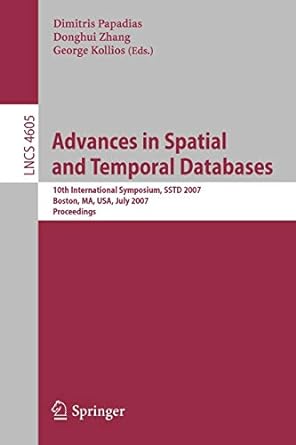Question
JAVA (I use Eclipse): Implement the enqueue(int x), dequeue() function for Queue in Queue.java. Then, implement the search(int k), insert(int x), delete() function in LinkedList.java.
JAVA (I use Eclipse):
Implement the enqueue(int x), dequeue() function for Queue in Queue.java. Then, implement the search(int k), insert(int x), delete() function in LinkedList.java.
I already have Stack.java completed. I included the code for reference.
Please do not modify the original code. Only include additional missing code in the provided structure. Please make sure the program works.
-----------------------------------
Below are the prepared codes to fill in:
package ds;
public class Stack {
public int size;
public int top;
public int[] array;
public Stack () {
size = 0;
top = -1;
array = null;
}
public Stack (int _size) {
size = _size;
top = -1;
array = new int[size];
}
/*
* Implement the Stack-Empty(S) function
*/
public boolean empty () {
return top == -1;
}
/*
* Implement the Push(S, x) function
*/
public void push (int x) {
if(top < size-1){
top++;
array[top] = x;
}
}
/*
* Implement the Pop(S) function
* Return -1 if the stack is empty
*/
public int pop () {
if(empty())
return -1;
int x = array[top];
top--;
return x;
}
/*
* Convert stack to string in the format of #size, [#elements]
*/
public String toString () {
String str;
str = size + ", [";
for (int i = 0; i <= top; i++)
str += array[i] + ", ";
str += "]";
return str;
}
/**
* @param args
*/
public static void main(String[] args) {
// TODO Auto-generated method stub
Stack s;
s = new Stack(10);
for (int i = 0; i < 5; i++)
s.push(i);
System.out.println(s.toString());
for (int i = 0; i < 2; i++)
s.pop();
System.out.println(s.toString());
}
}
-----------------------------------
package ds;
public class Queue { public int size; public int[] array; public int head; public int tail; public Queue () { size = 0; array = null; head = -1; tail = 0; } public Queue (int _size) { size = _size; array = new int[size]; head = -1; tail = 0; } /* * Implement the ENQUEUE(Q, x) function */ public void enqueue (int x) { } /* * Implement the DEQUEUE(Q) function */ public int dequeue () { } /* * Convert queue to string in the format of #size, head, tail, [#elements] */ public String toString () { String str; str = size + ", " + head + ", " + tail + ", ["; for (int i = head; i%size < tail; i++) str += array[i] + ","; str += "]"; return str; }
/** * @param args */ public static void main(String[] args) { // TODO Auto-generated method stub Queue q; q = new Queue(10); for (int i = 0; i < 5; i++) q.enqueue(i); System.out.println(q.toString()); for (int i = 0; i < 2; i++) q.dequeue(); System.out.println(q.toString()); }
}
-------------------------------------------------
package ds;
public class LinkedList { public ListNode head; public LinkedList () { head = null; } /* * Implement the LIST-SEARCH(L, k) function */ public ListNode search (int k) { } /* * Implement the LIST-INSERT(L, x) function * Note that x is a integer value, not a ListNode */ public void insert (int x) { } /* * Implement the LIST-DELETE(L, x) function */ public void delete (ListNode x) { } /* * Convert a LinkedList to a string in the format of [#elements] */ public String toString () { String str; ListNode n; str = "["; n = this.head; while (n != null) { str += n.key + ","; n = n.next; } str += "]"; return str; } /** * @param args */ public static void main(String[] args) { // TODO Auto-generated method stub LinkedList l; l = new LinkedList(); for (int i = 0; i < 5; i++) l.insert(i); System.out.println(l.toString()); for (int i = 0; i < 2; i++) l.delete(l.head.next); System.out.println(l.toString()); }
}
-----------------------------------------------------
package ds;
public class ListNode { public int key; public ListNode prev; public ListNode next; public ListNode () { prev = next = null; } public ListNode (int _key) { key = _key; prev = next = null; } }
Step by Step Solution
There are 3 Steps involved in it
Step: 1

Get Instant Access to Expert-Tailored Solutions
See step-by-step solutions with expert insights and AI powered tools for academic success
Step: 2

Step: 3

Ace Your Homework with AI
Get the answers you need in no time with our AI-driven, step-by-step assistance
Get Started


